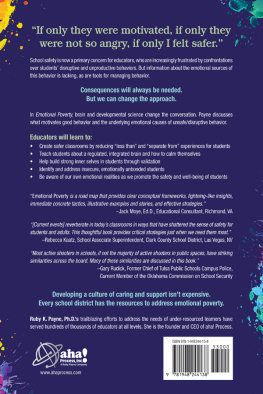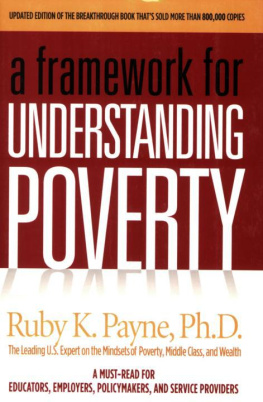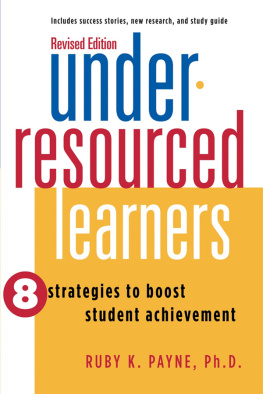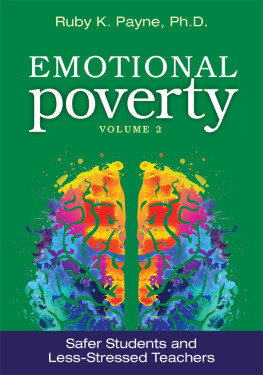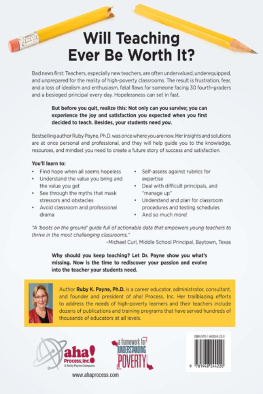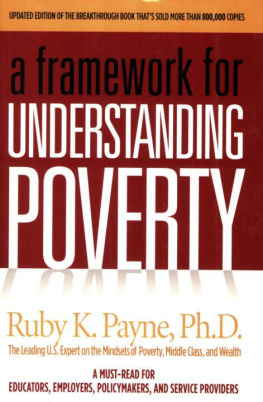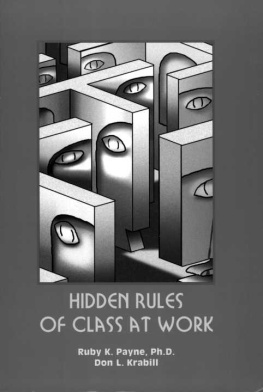Ruby K. Payne - Emotional Poverty in All Demographics
Here you can read online Ruby K. Payne - Emotional Poverty in All Demographics full text of the book (entire story) in english for free. Download pdf and epub, get meaning, cover and reviews about this ebook. publisher: aha! Process, Inc., genre: Home and family. Description of the work, (preface) as well as reviews are available. Best literature library LitArk.com created for fans of good reading and offers a wide selection of genres:
Romance novel
Science fiction
Adventure
Detective
Science
History
Home and family
Prose
Art
Politics
Computer
Non-fiction
Religion
Business
Children
Humor
Choose a favorite category and find really read worthwhile books. Enjoy immersion in the world of imagination, feel the emotions of the characters or learn something new for yourself, make an fascinating discovery.
- Book:Emotional Poverty in All Demographics
- Author:
- Publisher:aha! Process, Inc.
- Genre:
- Rating:3 / 5
- Favourites:Add to favourites
- Your mark:
- 60
- 1
- 2
- 3
- 4
- 5
Emotional Poverty in All Demographics: summary, description and annotation
We offer to read an annotation, description, summary or preface (depends on what the author of the book "Emotional Poverty in All Demographics" wrote himself). If you haven't found the necessary information about the book — write in the comments, we will try to find it.
Emotional Poverty in All Demographics — read online for free the complete book (whole text) full work
Below is the text of the book, divided by pages. System saving the place of the last page read, allows you to conveniently read the book "Emotional Poverty in All Demographics" online for free, without having to search again every time where you left off. Put a bookmark, and you can go to the page where you finished reading at any time.
Font size:
Interval:
Bookmark:
Acknowledgments
I would like to thank so many people who helped make this book possible.
First, there were all the readerspeople who took the time to read and comment on the drafts. Some of them even allowed their stories to be included in the book. To Bethanie Tucker, Jim Littlejohn, Ruben Perez, Chestin Auzenne-Curl, Michael Curl, Kirven Tillis, Kim Ellis, Karen Coffey, Galen Hoffstadt, Rickey Frierson, Rebecca Katz, Jack Moye, Cindy Kirby, Judy Weber, Roger Gallazzi, Pete Gleason, Gary Rudick, Haley Ford, Ellen Williams, Lynn Dodge, Rendy Belcher, Karen Barber, Vern Reed, Martinrex Kedziora, Jim Ott, Jennifer Hedinger, Sharon Ray, and Steve Johnson and his ESC VI staff members, I offer my heartfelt thanks for the insightful feedback, encouragement, and contributions. Larken Sutherland also provided so much insight and conversation.
Peg Conrad, VP of publications at aha! Process, was amazing as she always is and adapted her schedule to make the book happen. Jesse Conrad was a wonderful editor. Paula Nicolella's design makes the book easy to read, and Amy Perich designed our cover. Carlos Saiz-Perez, director of marketing and strategic digital development, was instrumental in getting the cover designed, as well as the PowerPoint and logos. Finally, and most importantly, I'd like to thank my husband, Tee Bowman, who is VP of sales development and operations. He was so helpful and thoughtful in this process of writing and revising. Thank you, Tee.
Appendix A
Study Guide
Emotional Poverty review questions
Introduction
1. What is the four-part definition of emotional poverty?
2. How does emotional poverty impact all economic groups, particularly affluent populations?
3. How is school safety related to this four-part definition?
4. What does the statement consequences will always be needed; it is the approach that needs to change mean?
5. Ninety percent of school discipline issues come from 1015% of the students. Think of a student you taught who falls into that 1015%. Please fill out the checklist for identifying emotional resources in the Introduction for that student. After you filled out the checklist, what did you learn about that student's emotional resources?
Chapter 1
1. Can you teach the hand model of the brain, a powerful mental model, to your class? Why would you do that? What is the benefit for the students?
2. Which parts of the brain have the most influence in determining and controlling an emotional meltdown?
3. What is the definition of an emotional meltdown?
4. Stosny says emotion is processed 2005,000 times faster than thought. Why is that information beneficial to know?
5. Compare and contrast calming techniques that you currently use with those that are suggested in . Which techniques are you willing to try?
Chapter 2
1. Brain development of the emotional self occurs from birth to three and again during adolescence, when the brain prunes and rewires itself. How is that process the same, and how is it different at those two times?
2. What is the role of self-construction?
3. How does Erikson's research on child development explain behaviors that you may see in the classroom?
4. Can you give examples of students who exhibit a difference between their emotional age and their chronological age?
5. Explain the difference between a weak inner self and a strong inner self.
6. How does adolescence shape a student's identity?
7. What is the difference between psychological control and behavioral control? Why is psychological control so damaging for adolescents?
8. How can a weak inner self lead to bad behavior? Why do many of the discipline techniques used in school actually increase bad behavior?
Chapter 3
1. What is bonding and attachment? How does it influence students and teachers interactions in the classroom?
2. Compare and contrast the significant attributes of the four attachment and bonding styles.
3. What discipline strategies have you used to address each of the bonding and attachment styles? Evaluate your results.
4. Identify which tools and strategies from you will use when there is a bonding and attachment issue that needs to be addressed.
Chapter 4
1. What is the impact of the repeated process of bonding, then separation, then individuation, and then new bonding on children and adults?
2. How does anger benefit the inner self?
3. Identify the significant impact anger, anxiety, and avoidance have on students.
4. What can you do to help an angry, anxious, or avoidant student or colleague?
5. Identify the differences between shame, humiliation, and guilt.
6. Examine the impact that feeling less than or separate from has on students and adults throughout their lives.
7. Explain how you had to deal with issues that created shame, humiliation, and/or guilt in and out of the classroom.
8. How can you reduce comments that tend to increase shame, humiliation, and/or guilt and increase comments that tend to help develop a strong inner self?
9. Evaluate how bullying has impacted you personally and how it has affected your students. How did you deal with both?
10. How does resentment impact your classroom? What can you do to reduce the impact?
11. Will your campus use the emotional triage process? How will that process keep students and staff safer?
Chapter 5
1. Why is there such concern over addressing issues related to gender differences?
2. Using the female/male tendencies or patterns chart in , evaluate the tendencies or patterns. Do they reflect your life experiences?
3. Why do many males have difficulty verbalizing emotions?
4. Why do males often need more time to process emotions?
5. How will you change your discipline approaches for more effectiveness with males?
Chapter 6
1. Who might the students and teacher bring with them to class every day? How might this impact what happens in the classroom?
2. What is the emotional dance that takes place in classrooms every day?
3. Compare and contrast emotional noise that is low and high. What are the attributes that create noise?
4. What are the issues, from the adult perspective, that impact the emotional dance in the classroom?
5. How does the bonding and attachment style of the student and the educator influence the emotional dance in the classroom?
6. Explain how a student's or educator's core inner hurts create emotional triggers.
7. How does the ebb and flow of the energy in our lifetime impact our ability to deal with stress? How does it impact classroom management?
8. How do the stages of adult development impact the emotional noise in the classroom?
9. Of the seven factors in adult development that are lifelong, which of those are most impacting you right now?
Chapter 7
1. Why is family function more critical for student success than family structure?
2. How might screen addictions, affluence, fatherless households, and adult addiction impact a less than and separate from external environment?
3. How might examining the results of the adverse childhood experiences (ACE) questionnaire benefit you in the classroom?
4. Why are students and parents with mental illness, biochemical issues, and/or personality disorders so challenging to work with in the classroom?
Chapter 8
1. What motivates good behavior?
2. What is the process of validation? Can you give an example of how you went through that process with a student?
3. If you can't change a student's behavior, how do you manage it?
Chapter 9
1. Examine the tools or strategies you currently use to reduce your own negative emotional responses to events in your life. How are they improving your life?
2. Which of the management strategies and tools from will you adapt to help your emotional stability?
Next pageFont size:
Interval:
Bookmark:
Similar books «Emotional Poverty in All Demographics»
Look at similar books to Emotional Poverty in All Demographics. We have selected literature similar in name and meaning in the hope of providing readers with more options to find new, interesting, not yet read works.
Discussion, reviews of the book Emotional Poverty in All Demographics and just readers' own opinions. Leave your comments, write what you think about the work, its meaning or the main characters. Specify what exactly you liked and what you didn't like, and why you think so.

